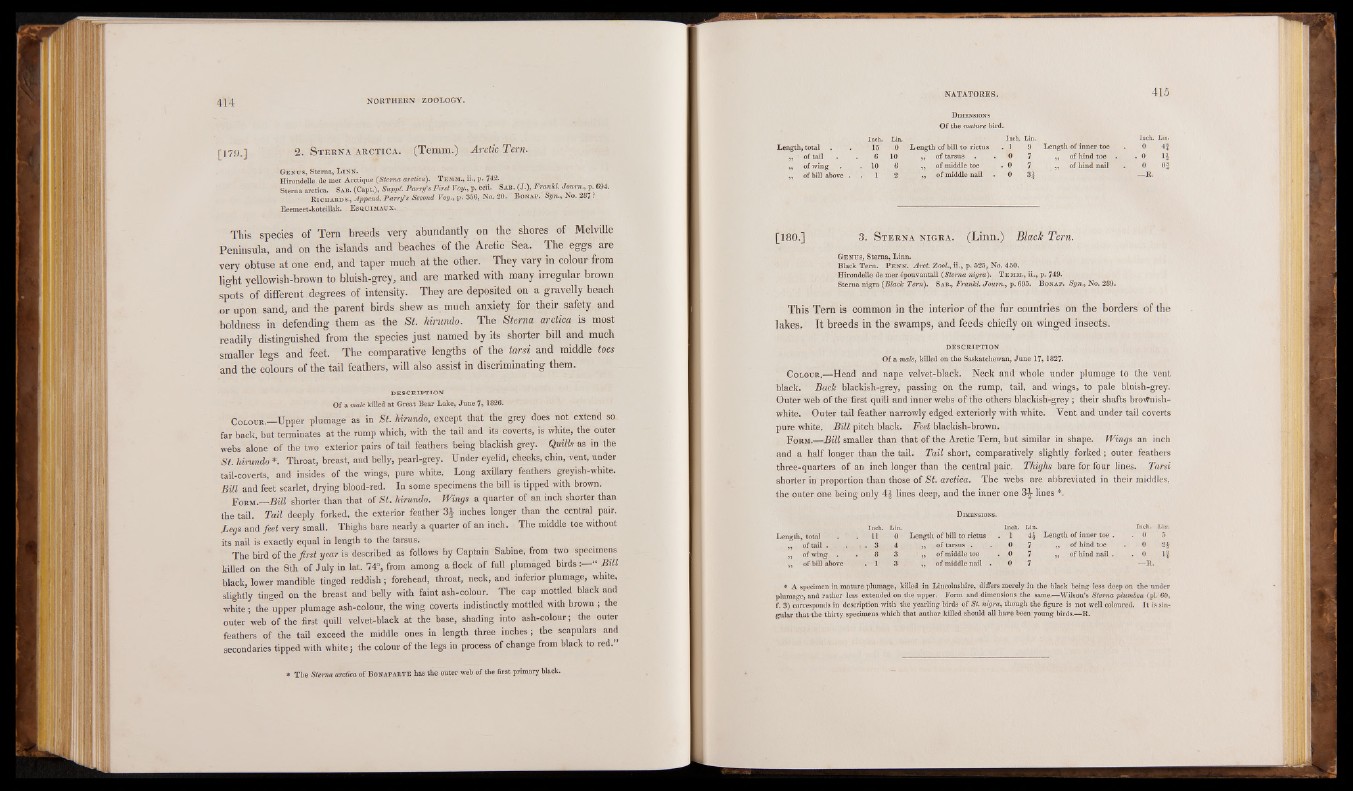
[179-] 2, Sterna arctica. (Temm.) Arctic Tern-
Genus, Sterna, Linn-.
Hirondelle de mer Arctique (Sterna arctica). Temm., ii., p. 742.
Sterna arctica. Sab. (Capt.), Suppt. Parry's First Voy., p. ecu. Sab . (J.), Frankl. Joum., p. 694. Richards., Append. Parry's Second Voy., p. 356, No. 20. Bonap. Syn., No. 287 •
Eeemeet-koteillak. Esquimaux.
This species of Tern breeds very abundantly on the shores of Melville
Peninsula, and on the islands and beaches of the Arctic Sea. The eggs are
very obtuse at one end, and taper much at the other. They vary in colour from
light yellowish-brown to bluish-grey, and are marked with many irregular brown
spots of different degrees of intensity. They are deposited on a gravelly beach
or upon sand, and the parent birds shew as much anxiety for their safety and
boldness in defending them as the St. hirundo. The Sterna arctica is most
readily distinguished from the species just named by its shorter bill and much
smaller legs and feet. The comparative lengths of the tarsi and middle toes
and the colours of the tail feathers, will also assist in discriminating them.
DESCRIPTION
Of a male killed at Great Bear Lake, June 7, 1826.
C olour.— Upper plumage as in St. hirundo, except that the grey does not extend so
far back, but terminates at the rump which, with the tail and its coverts, is white, the outer
webs alone of the two exterior pairs of tail feathers being blackish grey. Quilts as in the
St. hirundo *. Throat, breast, and belly, pearl-grey. Under eyelid, cheeks, chin, vent, under
tail-coverts, and insides of the wings, pure white. Long axillary feathers greyish-white.
Bill and feet scarlet, drying blood-red. In some specimens the bill is tipped with brown. Form —Bill shorter than that of St. hirundo. Wings a quarter of an inch shorter than
the tad. Tail deeply forked, the exterior feather 3J inches longer than the central pair.
Begs and feet very small. Thighs bare nearly a quarter of an inch. The middle toe without
its nail is exactly equal in length to the tarsus.
The bird of the first year is described as follows by Captain Sabine, from two specimens
killed on the 8th of July in lat. 74°, from among a flock of full plumaged b i r d s “ Bill
black, lower mandible tinged reddish ; forehead, throat, neck, and inferior plumage, white,
slightly tinged on the breast and belly with faint ash-colour. The cap mottled black and
white ; the upper plumage ash-colour, the wing coverts indistinctly mottled with brown ; the
outer web of the first quill velvet-black at the base, shading into ash-colour; the outer
feathers of the tail exceed the middle ones in length three inches; the scapulars and
secondaries tipped with white; the colour of the legs in process of change from black to red.”
* The Sterna arctica of Bonaparte has the outer web of the first primary black.
NATATORES. 41Ô
Dimensions
Of the mature bird.
Length, total 15 0 L ength of bill to rictus . 1 9 Length of inner toe 0 ,, of tail 6 10 ,, of tarsus 0 7 ,, of hind toe . . 0
,, of wing . . 10 6 ■ . „ of middle toe . 0 7 „ of hind nail „ of bill above . : .• ' 1 ‘ 2 ,, of middle nail H —R.
[180.] 3. Sterna nigra. ‘(Linn.) Black Tern.
Genus, Sterna, Linn.
Black Tern. P enn. Arct. Zool., ii., p. 525, No. 450.
Hirondelle de mer épouvantail (Sterna nigra). T em m ., ii., p. 749.
Sterna nigra (Black Tern). Sab., Frankl. Joum., p. 695. Bonap. Syn., No. 289.
This Tern is common in the interior of the fur countries on the borders of the
lakes. It breeds in the swamps, and feeds chiefly on winged insects.
DESCRIPTION
Of a male, killed on the Saskatchewan, June 17, 1827. Colour.—Head and nape velvet-black. Neck and whole under plumage to the vent
black. Back blackish-grey, passing on the rump, tail, and wings, to pale bluish-grey.
Outer web of the first quill and inner webs of the others blackish-grey ; their shafts brovfnish-
white. Outer tail feather narrowly edged exteriorly with white. Vent and under tail coverts
pure white. Bill pitch black. Feet blackish-brown. Form.—Bill smaller than that of the Arctic Tern, but similar in shape. Wings an inch
and a half longer than the tail. Tail short, comparatively slightly forked ; outer feathers
three-quarters of an inch longer than the central pair. Thighs bare for four lines. Tarsi
shorter in proportion than those of St. arctica. The webs are abbreviated in their middles,
the outer one being only 4£ lines deep, and the inner one 3J lines *.
Dimensions.
Length, total . . 11
L0in. Length of bill to rictus . 1
Lin.
4è Length of inner toe .
.I0nch. Litr. 5
,, of tail . > . 3 4 ,, of tarsus . 0 7 „ of hi nd toe 0 2§
,, of wing . 8 3 ' ,, of middle toe . .0 7 ,, , of hind nail . . 0 If.
,, of bill above . 1 3 of middle nail . 0 7 —R.
* A specimen in mature plumage, killed in Lincolnshire, differs merely in the black being less deep on the under
plumage, and rather less extended on the upper. Form and dimensions the same.—Wilson’s Sterna phinibea (pi. 60,
f. 3) corresponds in description with the yearling birds of St. nigra, though the figure is not well coloured. It is sin-,
gular that the thirty specimens which that author killed should all have been young birds.—R.